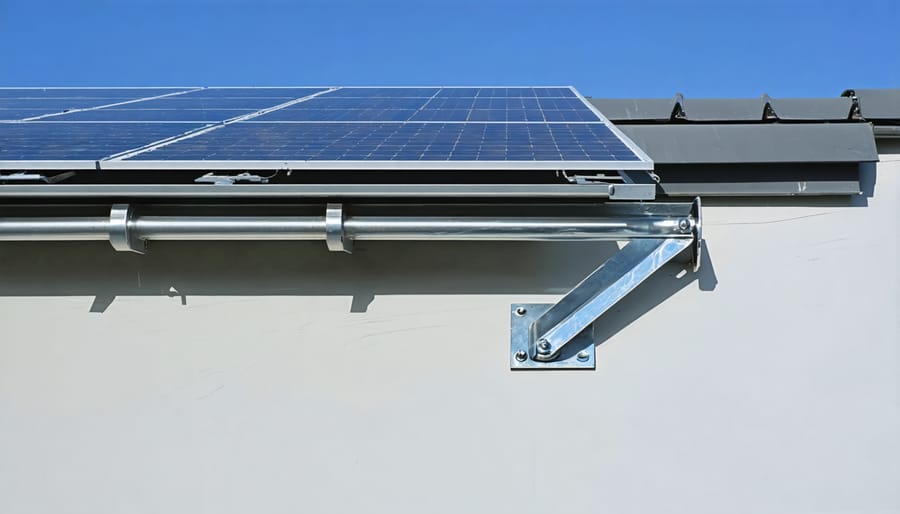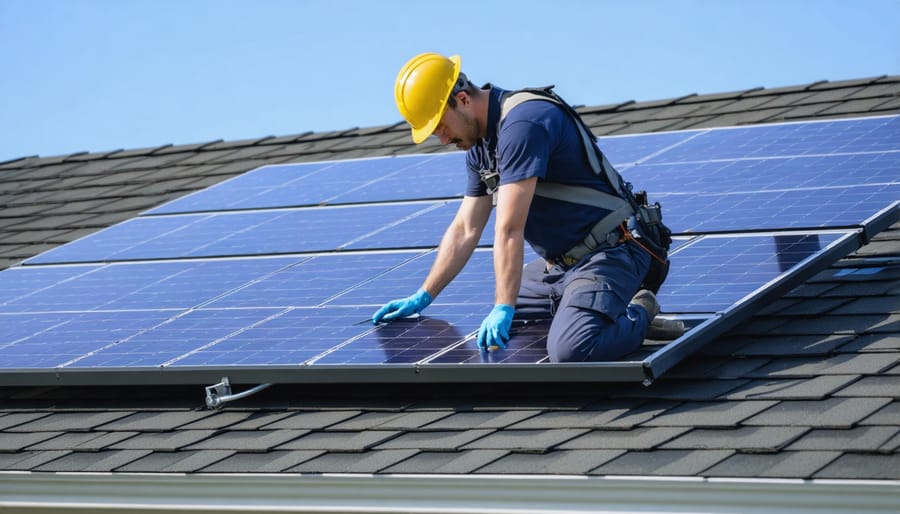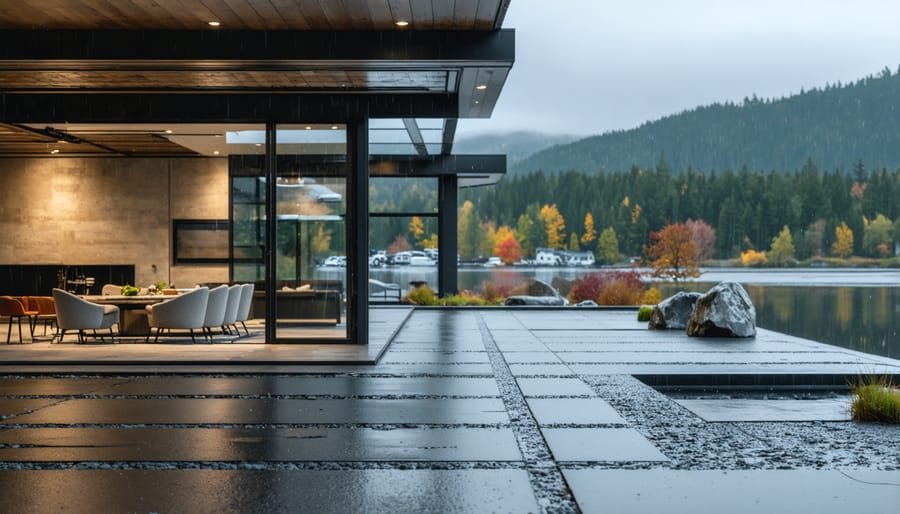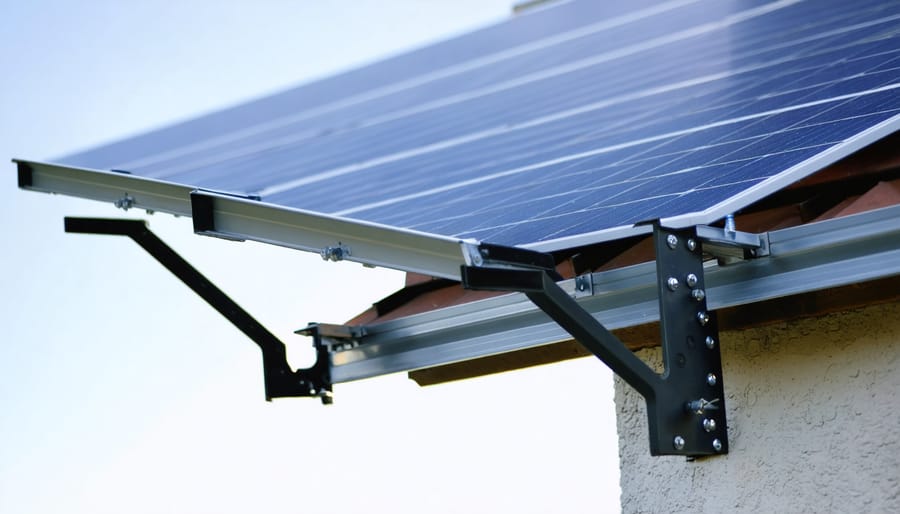Z-brackets serve as the critical foundation for secure solar panel installations across British Columbia’s diverse weather conditions. These robust mounting solutions transfer load directly into roof rafters, providing essential protection against BC’s heavy winter snow loads and powerful coastal winds. Installing solar panels with Z-brackets delivers up to 25% better structural integrity compared to standard mounting systems, while their adjustable design accommodates roof pitches from 15 to 45 degrees. For BC homeowners pursuing solar energy, selecting the right Z-brackets marks the difference between a decades-long successful installation and potential structural complications. With proper installation, these mounting systems maintain watertight roof integrity while supporting arrays that can generate over 1,200 kWh annually per kW installed – enough to power the average BC home’s essential needs.
Understanding Z Brackets in Solar Panel Mounting
What Makes Z Brackets Different
Z brackets stand out from traditional mounting systems due to their exceptional adaptability to British Columbia’s diverse weather conditions. Unlike standard L-brackets or rail-based systems, Z brackets provide superior strength and stability while maintaining a lower profile on your roof.
What truly sets Z brackets apart is their innovative design that creates a waterproof seal between the mounting point and your roofing material – a crucial feature for BC’s rainy climate. The raised portion of the Z shape effectively channels water away from the mounting point, significantly reducing the risk of leaks compared to conventional mounting options.
In BC’s mountainous regions where heavy snow loads are common, Z brackets excel by distributing weight more evenly across roof structures. Their robust construction typically allows for spans of up to 48 inches between mounting points, reducing the number of roof penetrations needed while maintaining structural integrity.
Installation time is notably reduced with Z brackets, as they require fewer components and steps compared to rail systems. This efficiency translates to lower labor costs and fewer potential points of failure, making them an increasingly popular choice among BC solar installers and homeowners alike.

Material and Build Quality
When it comes to mounting solar panels in British Columbia’s diverse climate, the material and build quality of Z brackets are crucial factors for long-term success. These mounting components are typically constructed from high-grade aluminum or stainless steel, materials chosen specifically for their exceptional resistance to corrosion and rust, even in coastal areas where salt spray is common.
The most reliable Z brackets feature marine-grade aluminum alloy, which offers an excellent strength-to-weight ratio while maintaining structural integrity through BC’s freeze-thaw cycles. For areas with heavy snowfall, such as the Interior or Northern regions, brackets are engineered to withstand loads of up to 2400 Pascals, ensuring your solar installation remains secure during winter months.
Look for brackets with anodized finishes, which provide additional protection against our wet coastal climate. The mounting hardware should include stainless steel bolts and nuts, preferably grade 316 for coastal installations or grade 304 for inland areas. Quality manufacturers also include EPDM rubber gaskets to prevent water infiltration at mounting points, essential for our rainy climate. These components work together to ensure your solar panel installation remains sturdy and weatherproof for decades, matching the longevity of the panels themselves.

Installing Solar Panels with Z Brackets in BC
Proper Placement and Spacing
Proper bracket placement is crucial for successful solar panel installation in British Columbia’s diverse climate conditions. For optimal performance and safety, Z brackets should be positioned at maximum intervals of 4 feet along each rail, with additional supports for areas experiencing heavy snow loads.
In coastal regions like Vancouver Island, where wind loads are significant, reduce spacing to 3 feet between brackets and install additional support points at roof edges. For interior BC locations such as Kelowna or Prince George, where snow accumulation is substantial, maintain 2.5 to 3-foot spacing and reinforce mounting points near the roof’s bottom edge.
Position Z brackets at least 12 inches from roof edges to maintain structural integrity. When aligning brackets, ensure they connect directly to roof rafters or trusses, never solely to decking material. Use a chalk line to mark straight installation paths and verify that all brackets are level before securing them.
For steep roof pitches common in BC’s mountain communities, install additional brackets at the top row to counter sliding forces from snow loads. In areas with high wind exposure, such as the Fraser Valley, incorporate mid-span supports between standard Z bracket positions to distribute load forces more evenly.
Remember to account for local building codes and snow load requirements specific to your municipality, as these can affect the required number and spacing of mounting points.
Weather-Specific Installation Tips
British Columbia’s diverse climate zones require careful consideration when installing solar panel z brackets. In coastal regions like Vancouver and Victoria, where rainfall is abundant, ensure brackets are properly sealed and coated with marine-grade protective materials to prevent corrosion. The salt air can accelerate wear, so regular inspection of mounting hardware is essential.
For interior regions like Kelowna and Kamloops, extreme temperature fluctuations demand special attention to thermal expansion. Allow adequate spacing between mounting points and use flexible washers to accommodate natural material movement. In northern areas such as Prince George, where snow loads on solar panels are significant, additional z brackets may be necessary to distribute weight evenly.
Mountain communities face unique challenges with high winds and heavy precipitation. Consider using reinforced z brackets and shorter spacing between mounting points. For areas prone to seismic activity, such as Vancouver Island, ensure brackets meet local building codes for earthquake resistance.
The wet coast requires careful waterproofing around roof penetrations. Use high-quality flashing and sealants rated for our climate. In drier interior regions, focus on heat-resistant materials that won’t degrade under intense summer sun. Always consult local weather data and building codes when planning your installation to ensure long-term reliability and safety.
Common Installation Mistakes to Avoid
Spacing and Alignment Issues
Getting the spacing right with z brackets is crucial for your solar panel system’s performance and longevity. Common mistakes include mounting brackets too close together, which can restrict airflow and reduce cooling efficiency, or too far apart, potentially compromising structural integrity during heavy snowfall or strong winds common in BC’s varied climate.
To achieve proper panel spacing, maintain a minimum gap of 20mm between panels for thermal expansion and ensure z brackets are positioned according to your panel manufacturer’s specifications. Misaligned brackets can create uneven weight distribution, leading to unnecessary stress on mounting points and reduced system efficiency.
Many BC homeowners have found that incorrect spacing can lead to water pooling, particularly problematic during our wet coastal winters. Additionally, improper alignment might create shadows between panels, reducing overall energy production. When installing multiple rows, maintain adequate spacing to prevent one row from shading another, especially during winter months when the sun sits lower in the sky.
Remember, proper spacing isn’t just about aesthetics – it directly impacts your system’s performance and durability in our unique BC climate.
Weather Sealing Errors
In BC’s notoriously wet climate, proper weather sealing of z brackets is crucial for maintaining your solar installation’s integrity. Common errors include inadequate flashing installation, improper sealant application, and failing to account for thermal expansion.
Always use high-quality EPDM or butyl rubber washers with your lag bolts, ensuring they’re properly compressed but not over-tightened. A frequent mistake is relying solely on roofing sealant without proper flashing, which can lead to water intrusion over time. Remember that sealant should be considered a secondary defense, not your primary waterproofing strategy.
When installing flashing, ensure it extends under the upper course of roofing material and overlaps the lower course properly. Many installers make the mistake of reversing this arrangement, creating a path for water to flow underneath. In BC’s coastal areas, where wind-driven rain is common, proper flashing technique becomes even more critical.
Pay special attention to penetration points and always use compatible materials – mixing different metals or sealants can lead to premature deterioration and leaks.

Maintenance and Long-term Care
In British Columbia’s diverse climate, proper maintenance of your solar panel Z brackets is essential for ensuring long-term performance and safety. Regular inspections should be conducted at least twice a year, ideally during spring and fall, with additional checks after severe weather events.
Start by visually examining all Z bracket mounting points for signs of rust, corrosion, or loose hardware. Along the coast where salt air exposure is common, inspect more frequently and apply marine-grade protective coatings as needed. In areas with heavy snowfall like the Interior, ensure snow guards are properly maintained to prevent excessive loads on the brackets.
Keep mounting hardware properly torqued according to manufacturer specifications. Weather cycling can cause thermal expansion and contraction, potentially loosening connections over time. Use a torque wrench during inspections to verify and adjust as necessary.
Clean any debris accumulation around the brackets, particularly fallen leaves and pine needles that can trap moisture. In areas with significant rainfall like the Lower Mainland, ensure water drainage paths remain clear to prevent pooling around mounting points.
Document all maintenance activities and any adjustments made. Taking dated photos during inspections helps track changes over time and can be valuable for warranty claims if needed. Many BC solar installers offer annual maintenance packages, which can be a worthwhile investment for peace of mind.
If you notice any concerning changes in panel alignment or bracket stability, consult with a qualified solar professional immediately. Addressing small issues promptly can prevent more significant problems and extend the lifespan of your mounting system.
Z brackets are essential components in successful solar panel installations, providing the sturdy foundation needed for long-term energy generation. Throughout British Columbia, properly installed z brackets have helped countless homeowners and businesses harness clean solar power while protecting their investments from our region’s challenging weather conditions. Remember to always prioritize high-quality materials, precise measurements, and proper installation techniques when mounting your solar panels. Whether you’re working with a professional installer or taking on a DIY project, following local building codes and manufacturer guidelines is crucial for safety and optimal performance. By taking the time to understand and properly implement z bracket mounting systems, you’re not just installing solar panels – you’re building a sustainable energy future for British Columbia, one roof at a time.

